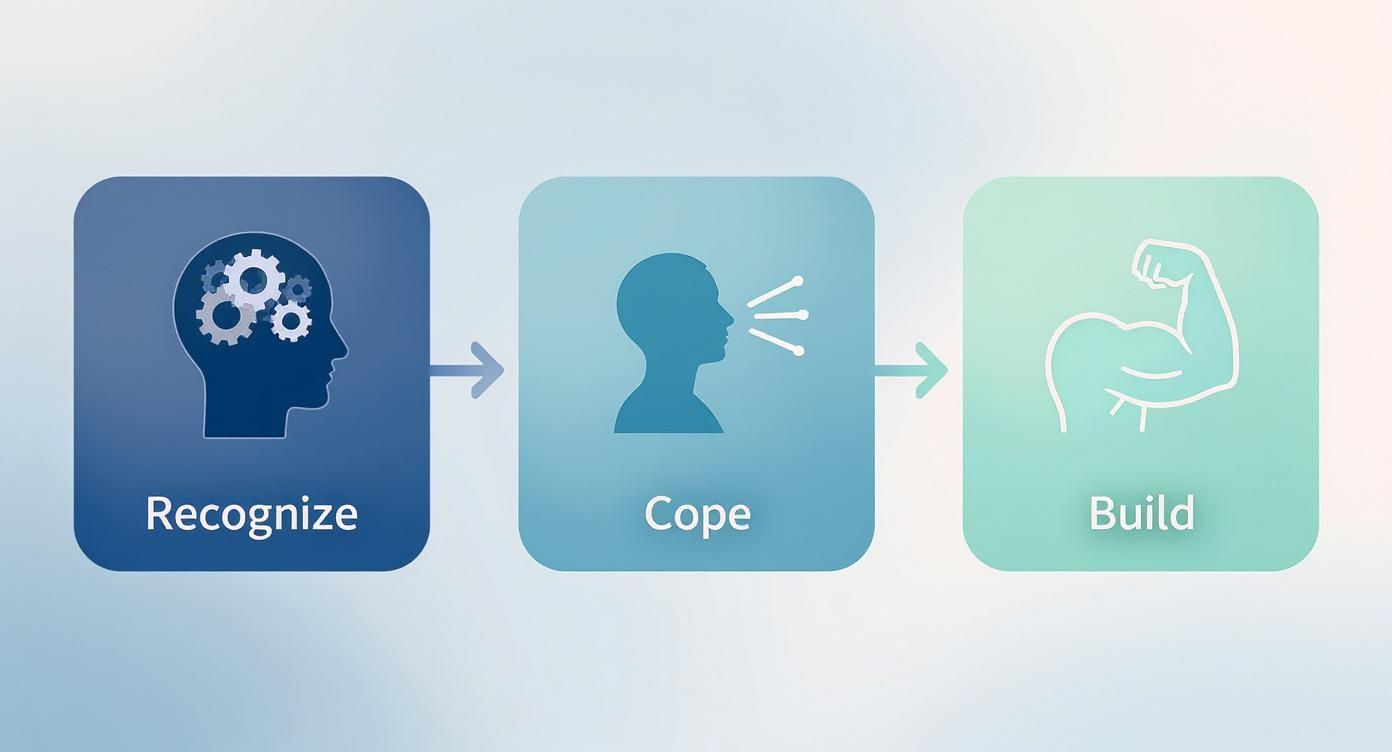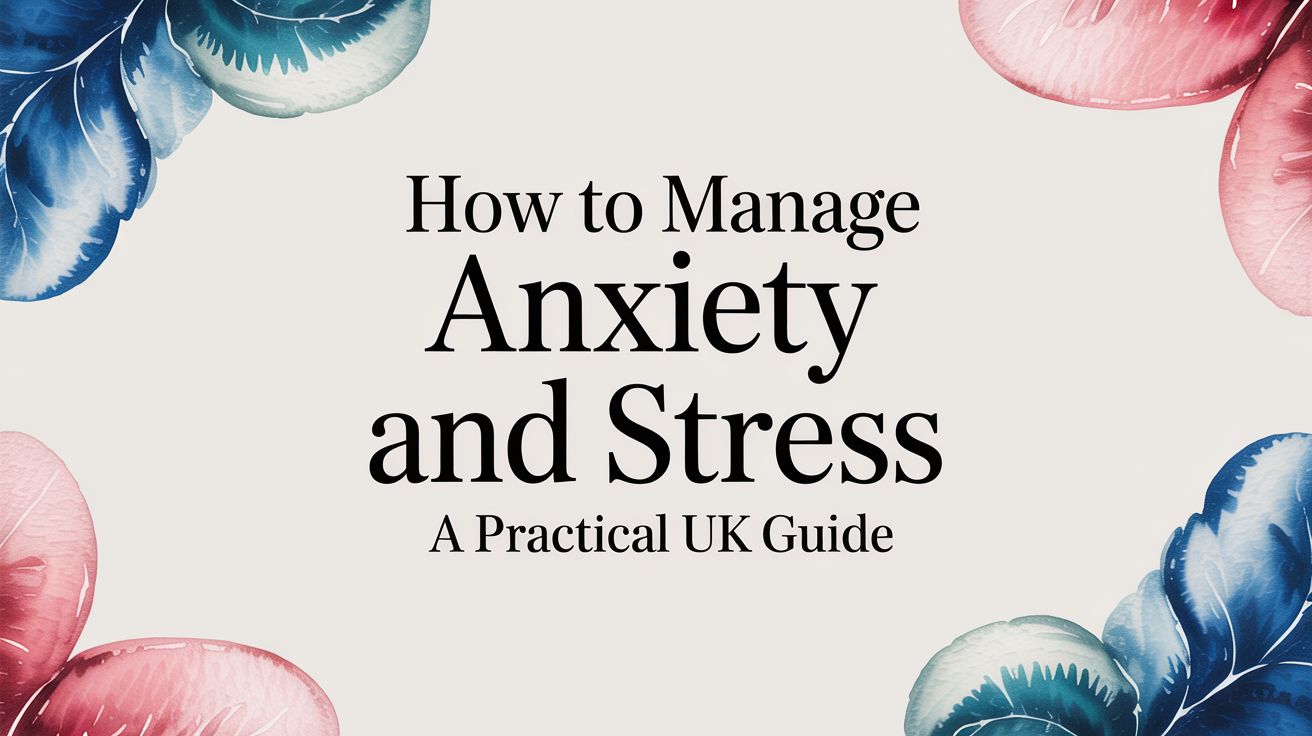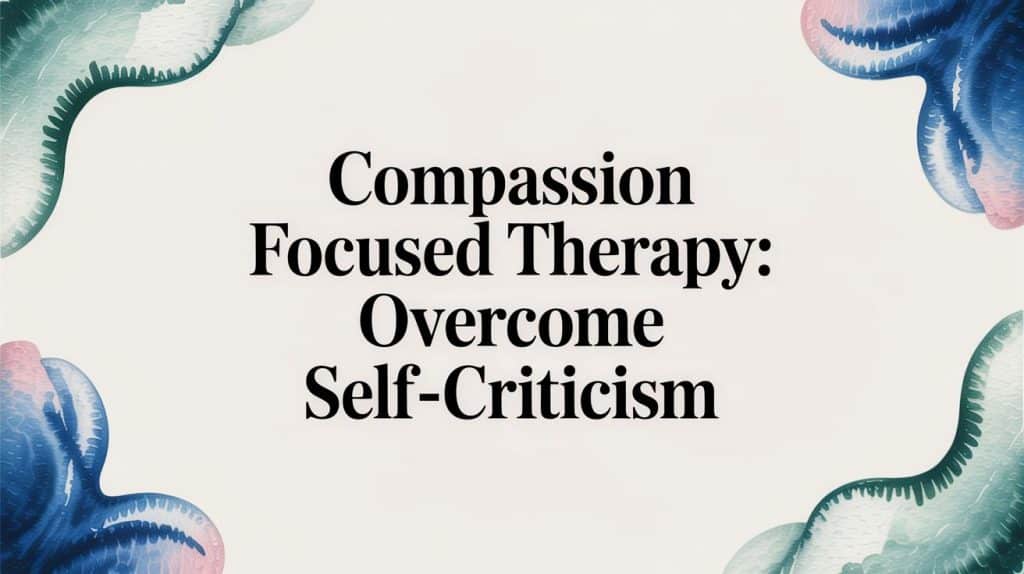Feeling swamped by stress and anxiety isn't just you; it’s a shared experience across the UK. Life today throws a lot at us. Demanding jobs, financial worries, and the never-ending stream of information from our phones all brew a perfect storm for feeling overwhelmed. It’s a completely normal response to the pressures we’re all facing.
So, the first step is just to acknowledge that. Your feelings are valid. This guide is here to help you move beyond simply 'getting through the day' and start building genuine, lasting resilience. We'll be walking through practical, evidence-based strategies, rooted in Compassion Focused Therapy, to help you find your feet and feel a sense of calm again.
The Mental Health Picture in the UK
There's no denying it, the conversation around mental health in the UK has shifted dramatically in recent years. It's become a critical part of our wellbeing, especially as challenges like anxiety have become more common.
The numbers really bring this home. Every single week, around 6 in 100 people in England are diagnosed with Generalised Anxiety Disorder (GAD). It’s a figure that shows just how many of us are struggling. The pressure on younger people is particularly intense; referrals for anxiety for those under 17 have more than doubled since before the pandemic. If you'd like to dig into the data, the Priory Group offers more insights on UK mental health statistics.
This guide is designed to give you real tools to navigate this reality, starting with things you can do right now.
What We'll Cover
Forget abstract theories. We're focused on practical techniques you can weave into your life straight away, building a proper toolkit for your mental wellbeing.
Here's what you can expect:
- Skills for the Moment: You'll learn simple ways to ground yourself when panic or overwhelm starts to creep in.
- Working with Your Thoughts: We’ll explore how to spot and gently challenge the anxious thought loops that keep you stuck.
- Building Lasting Resilience: We'll look at creating sustainable habits around sleep, movement, and self-kindness that protect your mental health for the long haul.
The goal isn't to get rid of stress completely—that’s just not realistic. It's about changing your relationship with it. When you learn to meet anxiety with awareness and a bit of self-kindness, you start to take its power away.
We’ll use everyday examples to show you how this all works in practice, whether you're dealing with a tough day at work, a difficult personal situation, or just trying to quiet a racing mind before you go to sleep.
When a wave of anxiety hits, it can feel like your thoughts are spiralling completely out of control. Your heart might race, your breath shortens, and the world suddenly seems incredibly loud and demanding. In these intense moments, trying to think your way out of the feeling often just makes things worse.
What you really need are immediate, physical actions that can anchor you back to the present moment.
These grounding techniques aren't about ignoring the anxiety. Far from it. They're about giving your brain something else to focus on, intentionally shifting your attention to your physical senses. Doing this interrupts the anxious feedback loop and sends a powerful signal to your nervous system that you are, in fact, safe.
This simple, three-step process shows how to recognise the signs of overwhelm, use coping skills to manage it, and then build resilience over time.

The key takeaway here is that managing anxiety is an active process—it starts with awareness, moves into immediate action, and is sustained by consistent practice.
Use Your Senses to Ground Yourself
One of the most effective in-the-moment tools I teach is the 5-4-3-2-1 grounding technique. It’s brilliant because it's discreet, simple, and you can do it anywhere—at your desk, on a bus, or in the middle of a crowded supermarket.
The goal is to pull your focus away from the internal storm of thoughts and emotions and reconnect with the external world through your five senses.
Here’s how it works:
- 5 – See: Look around you and mentally name five things you can see. Notice the small details. For example, "I see the blue pen on my desk, a tiny crack in the ceiling, the light reflecting off my screen, the leaves on my green plant, and the wood grain on the door."
- 4 – Touch: Acknowledge four things you can physically feel. This could be the texture of your trousers against your skin, the cool, smooth surface of your phone, the warmth of your hands, or the solid feeling of your feet flat on the floor.
- 3 – Hear: Listen for three distinct sounds. You might hear the low hum of a computer, distant traffic, or even just the quiet sound of your own breathing.
- 2 – Smell: Identify two different smells in your environment. Perhaps it's the faint scent of coffee from the kitchen or the soap you used on your hands earlier.
- 1 – Taste: Finally, notice one thing you can taste. It might be the lingering flavour of your morning tea or just the neutral taste inside your mouth.
This exercise is so powerful because it forces your brain to engage with the immediate, tangible environment, leaving less mental space for those anxious thoughts to thrive.
Regulate Your Breathing to Calm Your Body
When you feel anxious, your breathing often becomes shallow and rapid. This is a classic part of the body's 'fight-or-flight' response. The good news is that you can consciously reverse this by controlling your breath, which sends a powerful message back to your brain that the danger has passed and it’s time to relax.
A simple yet profound technique I often recommend is Box Breathing. Just visualise a square and breathe along with its four equal sides.
- Breathe in slowly through your nose for a count of four.
- Hold your breath for a count of four.
- Breathe out slowly through your mouth for a count of four.
- Hold your breath again for a count of four.
Repeat this cycle four or five times. The steady, rhythmic nature of this exercise helps regulate your heart rate and activates the parasympathetic nervous system—your body’s built-in relaxation response. As you practise, you may find tools like the CFT App helpful for guided exercises and building a consistent routine.
By focusing on the physical sensation of your breath and the counting, you give your mind a single, calming task. It’s a way of telling your body, "I am in control, and it is safe to slow down."
To effectively manage feelings of overwhelm, exploring other physical techniques can also be incredibly beneficial. For instance, some people find that learning about deep pressure therapy for anxiety offers another useful tool for soothing an overstimulated nervous system. The key is to find what works for you and to practise it, so it becomes second nature when you need it most.
How to Reframe Your Anxious Thoughts

Grounding techniques are brilliant for bringing calm back to your body, but what about the thoughts that kicked off the anxiety in the first place? Anxious feelings are almost always fuelled by the stories we tell ourselves. It’s these internal narratives that can quickly spiral into worry and self-doubt. Truly learning how to manage anxiety means getting to grips with these thoughts, not just battling against them.
The goal isn't to bulldoze your brain into "thinking positive" or to pretend your worries don't exist. That's a recipe for frustration. Instead, it’s about gently coaching your mind towards a more balanced and realistic point of view. When you start to compassionately question your automatic anxious thoughts, you loosen their grip and drain their emotional power.
Spotting Your Common Thinking Traps
First things first, you need to recognise the patterns. Anxious minds often fall into very predictable traps, what we call cognitive distortions in therapy. Think of them as unhelpful mental shortcuts your brain takes under pressure, often leading you way off course.
Once you can put a name to these traps, you can start to dismantle them. Here are a few of the usual suspects to watch out for:
- Catastrophising: This is the classic "what if?" spiral. You take a minor worry and your mind instantly leaps to the absolute worst-case scenario. A small mistake at work becomes, "I'm definitely going to get fired."
- Black-and-White Thinking: This is all-or-nothing thinking. Things are either perfect or a disaster, with no room for nuance. If you're not a complete success, you must be a total failure. There's no middle ground.
- Mind Reading: This is when you assume you know what other people are thinking about you—and it’s almost always negative. For example, "My boss was quiet in that meeting; she must think my ideas are terrible."
Just being able to spot these patterns is a huge step forward. It creates a bit of space, allowing you to see your thoughts for what they are—just thoughts, not undeniable facts.
A Framework for Questioning Your Thoughts
Once you’ve caught an anxious thought in the act, you can start to gently challenge it. This isn't about putting the thought on trial; it's more like a curious and compassionate inquiry. Imagine you're a kind detective, simply gathering evidence to see if the thought really holds up.
A simple set of questions can guide you. Let’s walk through a common scenario: you've been invited to a social event, and your immediate thought is, "I’ll be so awkward, and no one will want to talk to me."
Let’s put that thought to the test:
- What's the evidence for this thought? Have there been moments when you've felt awkward? Sure, probably. But what's the evidence against it? Have you ever had a pleasant chat at a party? Have people talked to you before? Be honest.
- Is there a more balanced way to see this? Instead of the absolute "no one will want to talk to me," a more balanced view might be, "I might feel a bit awkward at first, which is normal, but I'll probably find someone to chat with, even if it's just for a few minutes."
- What's the most likely outcome? Realistically, is it probable that every single person will actively ignore you all night? Or is it far more likely you'll have some neutral, and maybe even some pleasant, interactions?
- What would I tell a friend in this situation? If a friend came to you with this worry, you’d likely be much kinder. You might say, "Just go for a little while and see how you feel. You can always leave if you're not enjoying it."
This process isn't about aggressively proving your anxious thought wrong. It’s about revealing that it's just one of many possible interpretations of a situation—and usually not the most accurate one.
This skill, cognitive reframing, is a cornerstone of effective stress management. The prevalence of anxiety in the UK has risen sharply, with 23% of working-age adults now reporting high anxiety, especially since the pandemic. It’s no surprise that approaches like cognitive-behavioural therapy (CBT), which focuses directly on changing these thought patterns, are so widely recommended. You can explore more about anxiety in the UK today and see the bigger picture.
By consistently practising this gentle questioning, you train your brain to pause before it leaps to the worst conclusion. You create a vital bit of breathing room between a trigger and your emotional reaction. That space is where you get your sense of control back.
Building a More Resilient Lifestyle

Dealing with anxiety isn't just about getting through the tough moments. It's about consciously building a life that actively supports your mental health, creating a solid foundation that helps you weather whatever storms come your way. This means getting back to basics and focusing on the things that build resilience from the ground up, day in and day out.
Think of your wellbeing like a house. The stronger the foundations—things like sleep, nutrition, and movement—the more stable the whole structure will be when life starts shaking things. These aren't just 'nice-to-haves'; they are non-negotiable parts of any robust, long-term strategy for managing anxiety and stress.
The Foundational Pillars of Wellbeing
Our minds and bodies are deeply connected. It’s a simple truth, but one we often forget. When you’re physically run down, your emotional resilience plummets, leaving you far more vulnerable to stress. Nurturing your physical health is one of the most direct and powerful things you can do to find mental calm.
Here are the core areas to focus on:
- Quality Sleep: It’s no surprise that chronic poor sleep sends anxiety levels soaring. The goal is a consistent sleep schedule and a relaxing wind-down routine—maybe reading a book or listening to some calm music—to signal to your body that it’s time to switch off.
- Nourishing Diet: What you eat has a huge impact on your mood and energy. A balanced diet rich in fruits, vegetables, and whole grains helps to stabilise your blood sugar, which prevents those energy crashes that can feel a lot like anxiety.
- Regular Movement: Physical activity is a powerful antidote to stress. It burns off the adrenaline that builds up when we're anxious and releases feel-good endorphins. You don’t need to run a marathon. Consistency trumps intensity every time.
I know, trying to fit all this into a busy schedule can feel overwhelming. The key is to start small. Instead of aiming for an hour at the gym, why not try 'exercise snacks'? These are just short, 5-10 minute bursts of activity, like a brisk walk around the block on your lunch break or a few stretches at your desk.
Building resilience isn't about making radical, overnight changes. It's about weaving small, sustainable, and compassionate choices into the fabric of your daily life. Each small choice reinforces the next.
This gradual approach is what makes new habits stick. For instance, your wind-down routine could start with one simple change: putting your phone away 30 minutes before bed. That one small act can have a huge ripple effect on your sense of calm.
Creating Boundaries and Nurturing Connections
A resilient lifestyle goes beyond just physical habits; it extends to how you manage your energy and relationships. It's incredibly easy to become depleted without clear boundaries, leaving you with very little left in the tank to handle stress. Setting boundaries is a fundamental act of self-respect.
This might look like learning to say "no" to that extra commitment when you know you're already stretched thin. Or it could be scheduling dedicated 'offline' time where you are not checking work emails. It's all about protecting your time and energy so you can show up fully for the things that truly matter.
Just as important are your social connections. Meaningful relationships are a powerful buffer against stress. Making time for friends and loved ones isn't an indulgence, even when you feel busy—it's a critical investment in your mental health. A quick phone call or a coffee with a friend can offer a fresh perspective and that vital sense of belonging.
Finally, to build a life that truly supports you, you need to cultivate a kind internal environment. Understanding how to practise self-compassion is the key to emotional well-being and resilience, as it helps you navigate setbacks without piling on harsh self-criticism.
Ultimately, building a resilient lifestyle is an ongoing practice of tuning into your needs and responding with care. It's about creating a sustainable rhythm that puts your wellbeing first, giving you the strength and stability to handle whatever comes your way.
Of course. Here is the rewritten section, crafted to sound like it was written by an experienced human expert, following all your specified requirements.
Using Self-Compassion to Counter Workplace Stress
For most of us, work is a major source of stress. It’s a constant churn of tight deadlines, demanding projects, and tricky colleagues that can easily create a high-pressure cooker of an environment. But often, the pressure we feel from the outside world is magnified by our own harshest critic: that relentless inner voice that pounces on every mistake and whispers that we’re not good enough.
This is where the real work begins. It’s not about finding a new way to brace against external demands, but learning how to manage the internal fallout.
Bringing self-compassion into your professional life isn’t about letting yourself off the hook or suddenly lowering your standards. Not at all. Think of it as a more resilient and sustainable way to navigate the inevitable bumps and scrapes of a career. It’s about choosing to treat yourself with the same kindness and understanding you’d instinctively offer a friend who was having a tough time.
What Self-Compassion Actually Looks Like
Self-compassion isn't just a vague, feel-good idea; it's an active practice built on three core pillars. When you learn to lean on them together, you create a powerful internal buffer against the burnout and self-doubt that workplace stress can trigger.
- Self-Kindness over Self-Judgement: This is about making a conscious choice to be gentle with yourself when you mess up or feel you’ve fallen short. Instead of launching into a tirade of self-criticism, you meet the moment with warmth and understanding.
- Common Humanity over Isolation: This is the game-changing realisation that struggle, failure, and imperfection are not your personal failings—they are part of the shared human experience. You’re not the only one who feels overwhelmed or makes mistakes. Far from it. This simple fact connects you to everyone else.
- Mindfulness over Over-Identification: This means learning to observe your painful thoughts and feelings without getting completely swept away by them. You acknowledge the stress ("Wow, I'm feeling really anxious right now") without letting it become your entire reality ("I am a failure").
This shift in perspective is more critical than ever in the modern UK workplace. A recent burnout report revealed that a staggering 9 in 10 employees experienced high or extreme stress over the last year, with 34% battling symptoms of burnout. It’s a stark reminder that professional pressure is a widespread problem, making these internal coping skills absolutely vital for survival and long-term wellbeing. Discover more insights from the 2025 Burnout Report.
It's easy to confuse self-compassion with self-esteem, but they are built on very different foundations. Self-esteem is often conditional, rising and falling with our successes and failures. Self-compassion, on the other hand, is a constant source of inner strength, available precisely when we need it most—when we fail.
Self-Compassion vs. Self-Esteem
| Aspect | Self-Compassion | Self-Esteem |
|---|---|---|
| Foundation | Based on inherent self-worth as a human being; unconditional. | Based on external validation, achievements, and social comparison. |
| Response to Failure | Offers kindness and understanding; frames failure as a learning opportunity. | Can lead to harsh self-criticism and feeling worthless when you fail. |
| Source of Worth | Internal. You are worthy of kindness because you are human. | External. Worth is often tied to being "better than average" or successful. |
| Stability | A stable, reliable inner resource that's always available. | Fluctuates with performance and external feedback; can be fragile. |
Understanding this difference is key. While self-esteem can feel good, self-compassion provides a much more stable and reliable foundation for navigating the ups and downs of work and life.
Practical Self-Compassion Exercises for Your Workday
Bringing this idea into your day-to-day routine doesn't require an hour of meditation on a cushion. It can be woven into the fabric of your workday through small, intentional actions that make a surprisingly big difference.
Develop a Soothing Mantra
Just before a nerve-wracking meeting or a big presentation, your inner critic is probably at its loudest. A simple, self-compassionate mantra can be a powerful tool to calm your nervous system.
Instead of letting your mind spiral with "I'm going to mess this up," try gently and silently repeating something like:
- "This is a difficult moment, but I can get through it."
- "May I be kind to myself in this challenge."
- "It's okay to feel nervous; anyone in my shoes would."
Find a phrase that actually feels genuine to you. Repeating it a few times can be enough to shift you out of a threat-based mindset and into one of self-support.
Write a Compassionate Letter
Let’s say you’ve made a pretty big mistake on a project. Your automatic reaction might be to mentally tear yourself to shreds. This is the perfect moment to try a powerful exercise: write a compassionate letter to yourself about what happened.
Imagine you are writing to a dear friend in the exact same situation. You’d likely acknowledge their disappointment, but you’d also remind them of their strengths, the effort they put in, and the simple fact that one mistake doesn't define their entire worth. This exercise helps you step outside of that critical voice and actively practise a much kinder, more constructive one.
Self-compassion is not about ignoring your weaknesses; it's about motivating yourself with encouragement rather than criticism. It’s the difference between a supportive coach and a harsh drill sergeant—both want you to succeed, but their methods have vastly different impacts on your long-term wellbeing.
By consistently weaving these small acts of kindness into your response to stress, you start to rewire your brain. You're not just coping; you're building an internal ally who helps you navigate professional pressures with far greater resilience and emotional balance. It’s a healthier, more sustainable path to success.
When and How to Find Professional Support in the UK
While the self-management skills we’ve explored are a powerful part of the toolkit for managing anxiety, they aren’t the whole story. It’s just as vital to recognise when you might need more support than you can give yourself.
Reaching out for professional help is a sign of strength, not weakness. It shows you’re committed to your well-being. But deciding to speak to someone can feel like a huge step, and it can be difficult to know when to talk to a mental health professional. A few clear signs can tell you it might be time.
Key Signs It Is Time to Seek Help
If stress and anxiety are consistently getting in the way of your daily life, that's a clear signal to seek support. This isn't about having the occasional bad day; it’s about a persistent pattern that stops you from functioning well and enjoying life.
Think about reaching out if any of this feels familiar:
- Your daily life feels disrupted: You struggle to get to work, manage things at home, or your relationships are suffering because of how you feel.
- Your mood is persistently low: You feel hopeless or sad most of the time, and the self-help strategies you’ve tried just aren’t shifting that feeling.
- You're experiencing physical symptoms: Perhaps you’re dealing with ongoing headaches, digestive issues, or a sense of chronic fatigue that seems tied to your stress levels.
- You're leaning on unhealthy coping habits: You find yourself relying on alcohol, food, or other behaviours to numb difficult feelings.
These aren't things you just have to put up with. They are important signals from your mind and body that a bit more support could make a real difference.
Navigating Your Options in the UK
Getting help in the UK can feel a bit confusing at first, but there are some clear and well-trodden pathways available. For most people, the first port of call is their General Practitioner (GP).
Your GP can assess what’s going on, rule out any physical causes for your symptoms, and talk you through the treatment options. They are the main gateway to NHS mental health services and can refer you to talking therapies like Cognitive Behavioural Therapy (CBT), which has proven to be highly effective for anxiety.
Here are the main routes you can explore:
- NHS Talking Therapies: In many areas, you can actually self-refer to your local NHS talking therapies service (what used to be called IAPT) without even seeing your GP. These services offer free, evidence-based treatments like CBT.
- Private Therapy: If you'd prefer to, or if NHS waiting lists are long, you can seek therapy privately. This often gives you more choice over the type of therapist and the therapeutic approach. Exploring options like Compassion Focused Therapy in the UK can provide specialised support, particularly for difficulties rooted in self-criticism and shame.
- Charity and Third-Sector Support: Organisations like Mind and Anxiety UK offer brilliant resources, from helplines to local support groups, that can provide immediate advice and a powerful sense of community.
Remember, the goal of therapy isn't to "fix" you, because you are not broken. It is to provide you with a safe space, new skills, and a supportive relationship to help you navigate your internal world more effectively.
Taking that first step, whether it’s booking a GP appointment or looking up a local charity, is a truly courageous move towards feeling more in control and improving your well-being.
At Dr Chris Irons, I offer specialised Compassion Focused Therapy to help individuals manage anxiety, overcome self-criticism, and build a kinder relationship with themselves. Learn more about my approach and how I can support you at https://drchrisirons.com.


